How to use ChatGPT to write — without cheating or getting flagged
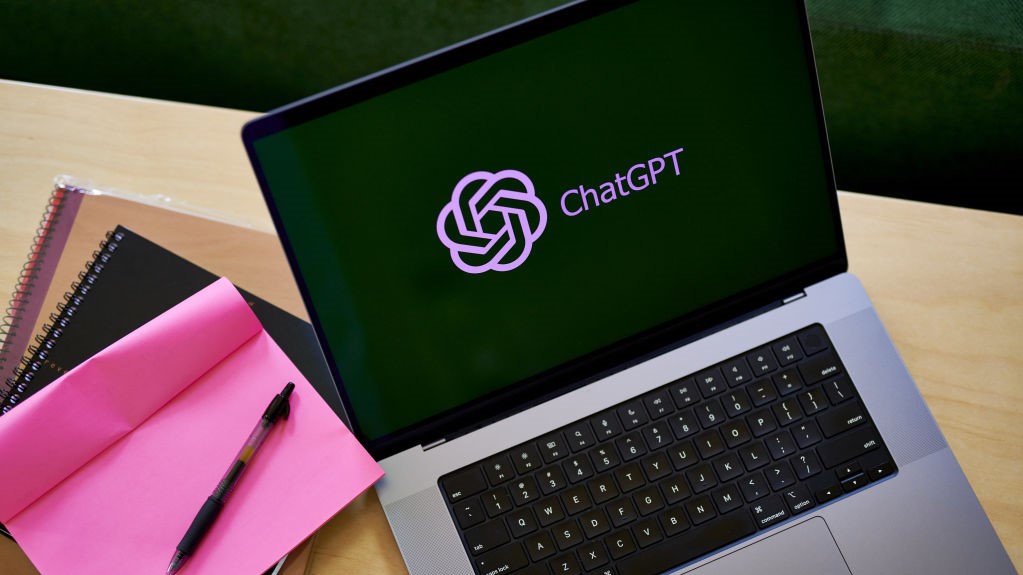
We’ve all seen the viral videos of professors calling out students for using AI to write their term papers. Not only is this against the rules at most universities, but it just feels icky.
Sure, it may seem like a win at the eleventh hour when the work is finally done, but I’m going to let you in on a little secret: there’s a way to use AI to write that isn’t cheating and you’ll pass through all those AI detectors with flying colors. Even better? You’ll actually learn in the process.
And this technique isn’t just for students. Log in to LinkedIn for even a few minutes and you’ll see plenty of professionals using AI to do all their writing for them. It’s easy, it’s fast and well, obvious.
As a lifelong writer and someone who tests AI for a living, I’m going to show you how to lean into AI without losing your voice, your scholarship/job or your dignity.
Step 1: Pick your chatbot
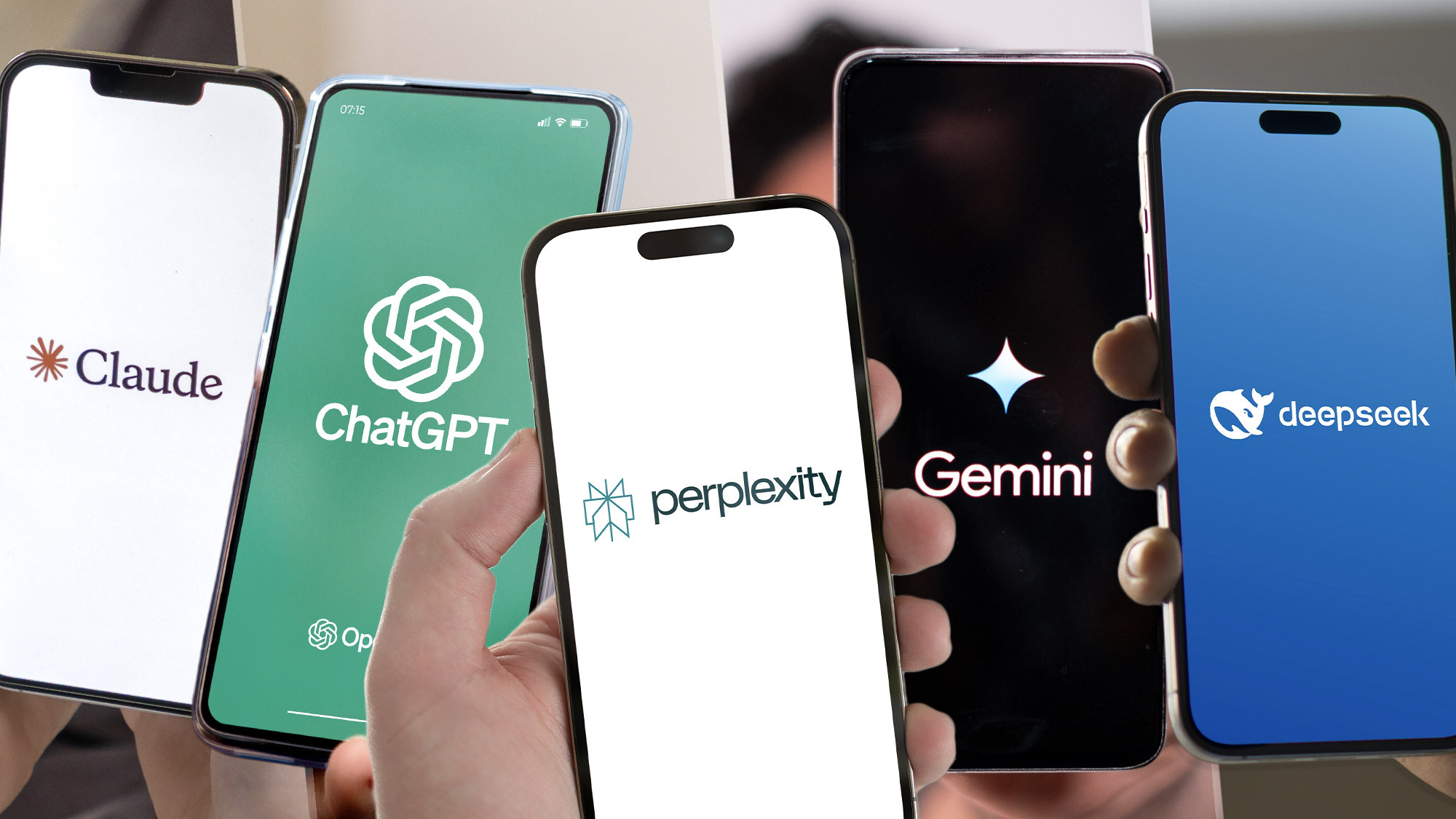
For many, the default chatbot is ChatGPT. It’s often synonymous with AI itself. Just the other day I had someone ask me “What’s another good ChatGPT for writing.” I knew she meant chatbot.
While ChatGPT-5 is good, ChatGPT-4 is even better, so you’re going to want to subscribe to ChatGPT Plus or use Microsoft Copilot if you plan on using AI regularly for writing. Gemini isn’t my first recommendation for writing, but Google has a really great discount for students that’s worth looking into.
Plus, Gemini 3.0 should be here any day now, which could change my opinion. Claude Pro is definitely my favorite chatbot at the moment and I’ve used it hundreds of times as a writing partner. Since ChatGPT is the most universally used, I’ll focus on it for this demonstration.
Step 2: Tell the chatbot what you’re working on
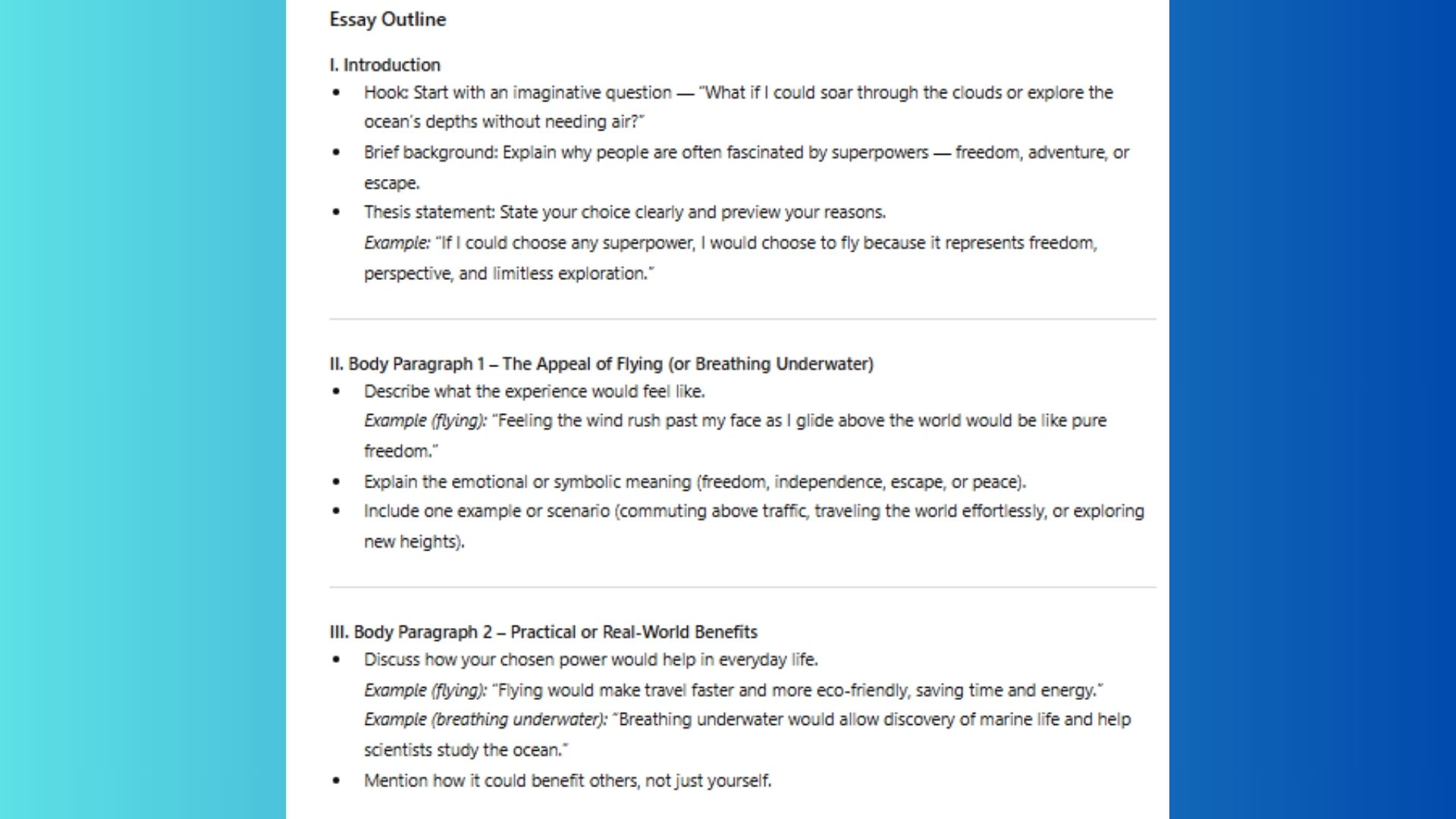
Prompt: “I’m writing an essay on the following question: If you had a superpower would you know how to fly or breathe under water? Create an outline.”
This is one of my favorite questions and I’ll tell you at the end which one I’d choose. So, for this demonstration, I will make it the topic of my essay. I don’t know about you, but the hardest part about writing is that initial blank page. I’ll often brainstorm what I’m going to write before I get to my computer just so I don’t show up with nothing. But even then, the first sentence can be intimidating.
Get instant access to breaking news, the hottest reviews, great deals and helpful tips.
That’s where AI can help. By asking for an outline you’re using AI to help you gather your thoughts, not write them for you. This is also a good time to add anything else your professor has requested like “I need to include two real-life examples, must use AP style, etc.”
This prompt helps you pinpoint what you’re going to say. You’ll notice that it suggests starting with a question. My professors always told me not to do that, but it’s still valuable guidance. Based on the advice from ChatGPT, I might begin my essay with something like:
Many people imagine having superpowers like invisibility or super strength, but ever since I was young, I’ve often thought about a simpler choice: the ability to fly or to breathe underwater.
Step 3: Move on to the body of the essay
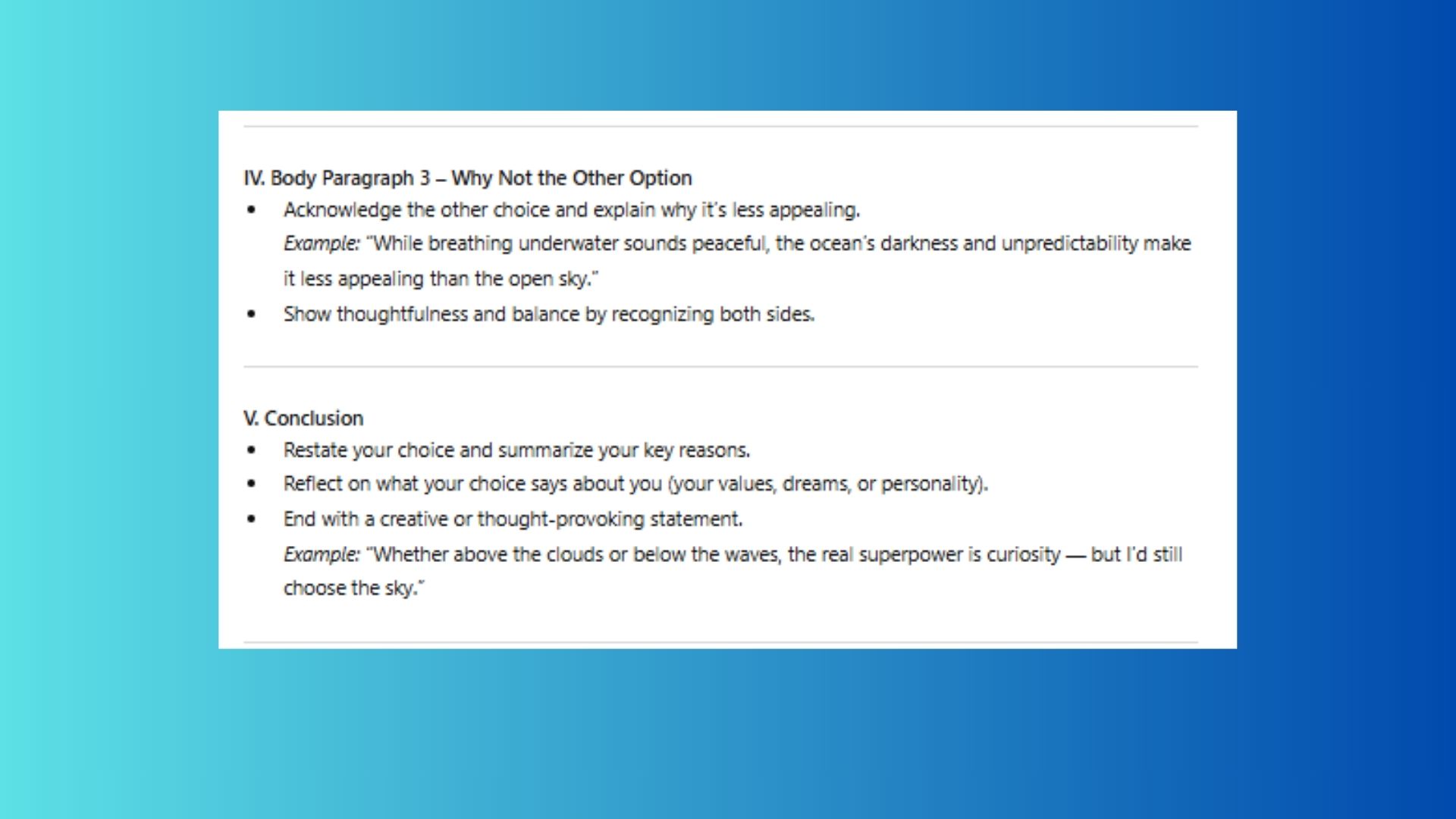
Once you’ve gotten that first sentence down with the hook, you’ll feel like a weight has been lifted. Continue the intro with another sentence or two. But if the juices still aren’t quite flowing, look back at your outline. In this case, you’re going to elaborate on the topic a little more in the first paragraph.
ChatGPT tells you exactly how:
Describe what the experience would feel like.
Example (flying): “Feeling the wind rush past my face as I glide above the world would be like pure freedom.”
Explain the emotional or symbolic meaning (freedom, independence, escape, or peace).
Include one example or scenario (commuting above traffic, traveling the world effortlessly, or exploring new heights).
Everything is done in your own words, you’re just leaning on AI to help you through the process. Lean on AI enough for an outline and you’ll discover that you may not even need help anymore. You’ll get the process down. For me, seeing an outline makes the work seem possible. I remember staring at directions on any given syllabus thinking, “There’s no way. Where do I even start?”
Step 4: Ask for feedback
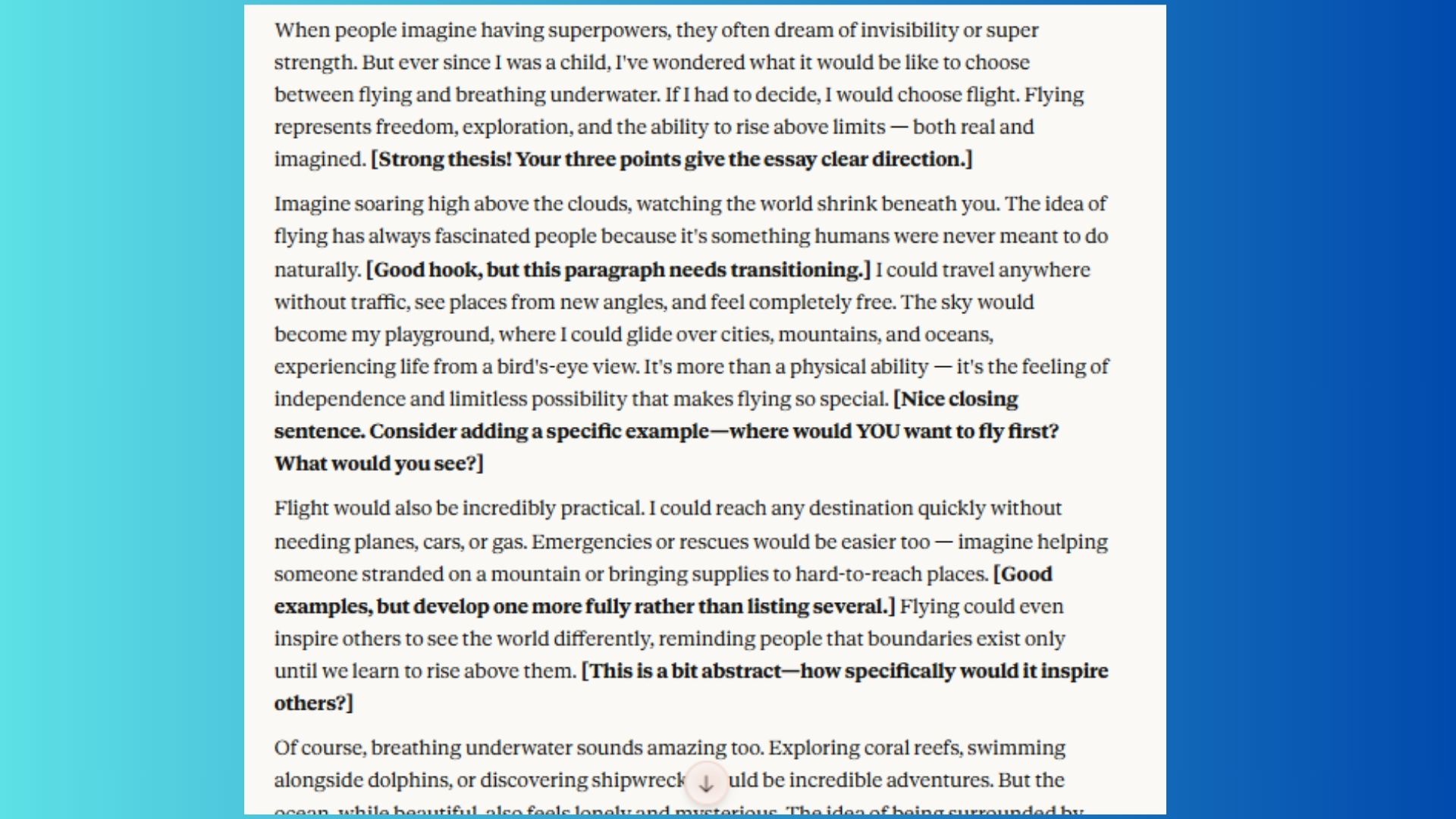
This outline is extremely detailed, which is helpful to be sure you don’t miss anything. Once you’ve touched on all aspects of the outline and your essay is complete, upload it to the chatbot and ask it to read it as your professor/boss/editor.
Try the prompt: “Read through this as my English professor and give me constructive criticism.”
This is where ChatGPT Canvas or Gemini Canvas can support you, again, not writing anything for you. When you open Canvas you can see edits the AI suggests.
You’ll get notes on your essay just like a professor or editor would offer. You can either take AI’s advice or skip. Superhuman, formally Grammarly, also offers feedback and even a grade, so that is worth trying. Just remember not to have the AI edit for you — you don't want any AI writing in your draft at all.
Final thoughts
Some people have an all-or-nothing approach to using AI for writing. Either AI writes the whole thing, or AI is ignored completely over fears that the work will be compromised. I use it as a helpful writing partner that allows me to gather my thoughts, shape my story and grade the final outcome.
AI is here to stay and as it integrates more into our daily lives, knowing how to use it to complete hard tasks can be a game changer at school and work. Think of it as your secret superpower so you don’t have to stay up as late when you have an essay due. Speaking of superpowers, I’d rather know how to breathe under water than fly. How about you? Let me know in the comments how you use AI for writing and which superpower you’d choose.
Follow Tom's Guide on Google News and add us as a preferred source to get our up-to-date news, analysis, and reviews in your feeds. Make sure to click the Follow button!
More from Tom's Guide
- I just gave ChatGPT, Gemini and Claude the same job interview — here’s who got hired
- I pitted Wikipedia against Elon Musk’s new Grokipedia — here’s which one gave the better answers
- I built 5 fun apps using Gemini AI Studio — including a cat meow translator

Amanda Caswell is an award-winning journalist, bestselling YA author, and one of today’s leading voices in AI and technology. A celebrated contributor to various news outlets, her sharp insights and relatable storytelling have earned her a loyal readership. Amanda’s work has been recognized with prestigious honors, including outstanding contribution to media.
Known for her ability to bring clarity to even the most complex topics, Amanda seamlessly blends innovation and creativity, inspiring readers to embrace the power of AI and emerging technologies. As a certified prompt engineer, she continues to push the boundaries of how humans and AI can work together.
Beyond her journalism career, Amanda is a long-distance runner and mom of three. She lives in New Jersey.
You must confirm your public display name before commenting
Please logout and then login again, you will then be prompted to enter your display name.










